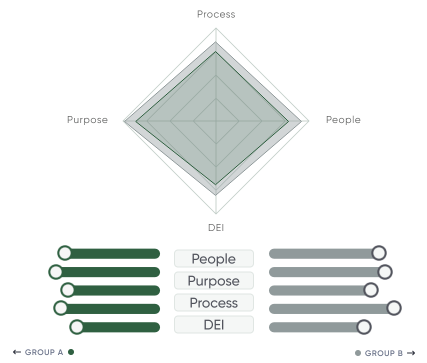Unlock the Power of Organizational Culture Surveys: A Guide for HR Leaders

Related Insights
The Value of an Organizational Culture Survey
Your business wouldn’t dream of making a decision about finance, marketing, or operations without informed data, and yet, everyday businesses make decisions about people without this critical information. The real value behind an organizational culture survey is a data-driven approach to understanding your company culture, just as you would use for any other business segment. This means collecting metrics and identifying areas of strength and opportunity to improve employee engagement and move your business forward.
Think beyond a “check-box” approach to running a culture survey, which often leads to survey fatigue and lackluster action. Employee feedback realizes its full potential when we use it to enable targeted interventions and initiatives that enhance your organization’s culture and support business goals. You can do this by understanding how your team is weathering organizational change, recognizing the insights most connected to productivity and retention, and creating a strong company culture throughout the process.
Your Leaders' Impact on Organizational Culture
With fluctuating markets, rapidly advancing technology, and varying degrees of flexibility in the post-pandemic environment, measuring employee experience regarding change can be overwhelming. However, there is one matter of change that outweighs the impact of all of these factors combined and that we have the ability to isolate to a moment in time: the movement of people. Utilizing company culture survey questions to assess the impact of recent leadership changes can provide valuable insights and accelerate the integration and success of your team.
Leaders have an outsized impact on the output of your business. While you’ve likely assessed whether the team leaders you’ve hired are well-suited for their position, most organizations fail to recognize the importance of evaluating leadership impact on culture following that transition. Utilizing organizational culture surveys to gauge employees’ perceptions and sentiments amidst leadership changes equips leaders with the feedback they need to hit the ground running and better support team members during uncertain times. Moreover, if you have measured culture before this transition, it is an opportunity to analyze survey results and identify potential shifts in culture and engagement levels.
A Powerful Tool for Creating Change
The dominant challenge business leaders encounter when running a culture survey isn’t collecting benchmark data, but understanding what to do with it. “Low” scores help identify general areas of improvement, but how do you know which is meaningful or important to focus on? There is a distinct difference between culture and engagement. Organizational culture, put simply, is the sum of total behaviors that surround us at work. It’s how we talk about the meaning and impact of our work. It’s the way we interact and connect with our team. It’s how we get the job done. In contrast, engagement measures our willingness to show up and actively participate in whatever that culture is.
The power of workplace culture surveys is maximized when culture metrics are leveraged to pinpoint the specific drivers of engagement. At Chapman & Co., we go beyond simple correlation and survey templates to conduct a complex statistical analysis to uncover the key cultural elements that are predictive of employee engagement within your organization. In some cases, this uncovers what is possibly presumed. For example, “I feel safe at work” was a cultural element identified in manufacturing work environments as a key driver of engagement. In other cases, there might be more surprising findings.
In a non-profit work environment, survey responses uncovered that team members were highly motivated by personal growth, as opposed to personal fulfillment. This was pivotal as many purpose-driven organizations often emphasize the commitment to a cause to increase employee satisfaction. In contrast, our analysis revealed that a commitment to the personal development goals of each team member in their roles would be a much more effective method of increasing engagement. Using a work culture survey to identify key factors to improve not just culture, but also engagement, will help your leaders to develop action plans that inform decision-making and drive results.
Once you’ve narrowed in on engagement factors, you can level up your action planning by ensuring cultural consistency across all employees, departments, and locations. Particularly for multi-location organizations, maintaining a cohesive culture can be difficult. Add a language barrier for global organizations and it may feel near impossible. Tailoring your employee engagement surveys to capture location-specific results will enable your leaders to identify discrepancies between teams. As you implement company-wide initiatives to foster culture consistency, you can then simultaneously provide focused support in the areas that most need it. There is a saying in carpentry that you should “measure twice, cut once.” The same applies here. By monitoring progress and conducting regular pulse surveys, you’ll avoid spending duplicative resources on efforts that aren’t positively impacting your culture improvement goals.
Elements of an Effective Culture Survey
What’s the last survey you took where you thought “Now that was awesome.” I’m going to go out on a limb and say it definitely wasn’t your company’s workplace culture survey, and more than likely you’ve never actually had that thought. We don’t take surveys because they’re fun. We take surveys because we believe that something will change as a result of providing our feedback. The bottom line is that designing and implementing an effective culture survey is less about the survey itself, and more about the efforts surrounding those precious 10-15 minutes completing multiple choice and open-ended questions.
This starts with defining your why and identifying clear objectives and scope for the survey. Employee engagement drives business results, therefore your culture objectives should be linked to your company values and your organizational goals. Designing with the end in mind means you can select employee survey questions that reflect the data you need to move forward. After design, it’s time to consider the plan for employees to take the survey. Think of the survey as an act of engagement in and of itself. Rather than mandating completion, your goal should be to inspire participation through meaningful communication about the initiative.
To do so, you’ll want to convey two critical components about your survey: 1) that change will happen in response to feedback shared and 2) that team members’ individual responses will remain anonymous. The most effective way to engage team members is through the buy-in of their team leaders. Regardless of their management style, direct leaders have a better chance of ensuring high participation rates through their personal commitment to action with their team. We recommend partnering with a third party to ensure the anonymity of respondents and the highest level of data integrity before, during, and after survey completion.
While your leaders are mulling over the data, your team members are waiting and watching for what comes next. When it comes to communicating survey results, there is no Switzerland. Your organization’s response to the data will either build or erode trust. Building a healthy company culture requires that you take your survey results to your team. Communicate honestly, transparently, and authentically about the results. And most importantly, convey your plan for action in response.
Positive Company Culture Drives the Bottom Line
Culture isn’t static and the current job market puts engagement up for grabs. When implemented strategically, organizational culture surveys can empower HR leaders with a data-driven approach to align employee engagement with desired business outcomes. Ongoing culture assessment and culture improvement will equip leaders to be better positioned to implement change, improve employee engagement, and unify their growing business.
HR leaders – the ball is in your court. Don’t let your people be the one area where your business makes uninformed decisions. Contact us today to leverage their perspectives as a catalyst for success through the strategic implementation of an organizational culture survey.







